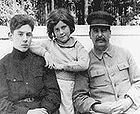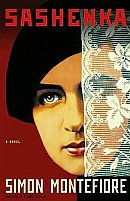HISTORICAL
FICTION
|

|
|

|

Stalin
with his children
|

An
example of Stalin's Terror during
the times in which Shashenka lived:
Part of list of names to
people to be executed and |

1920 Russian
Entente
propaganda poster. The theme of deceit under masks was a common
warning in Russian propaganda and in Sashenka's mind during her
Bolshevik period
|
|
BOOK
ILLUMINATIONS
From Merrimon Book Reviews
HOME
ROMANCE
FICTION SUSPENSE & THRILLERS
MYSTERY
AUTHORS REVIEWER
PROFILES
|
Sashenka

by Simon Montefiore

Russian
History and
Stalin's Terror through the eyes of family
In 1916 St. Petersburg, a governess
affectionately called Lala picks up Sashenka from the Smolny Institute
for Noble Girls. As she completes her last class before the winter
break, Sewing for the Tsar and the Motherland, Russia itself is poised
on the edge of a revolution that will overturn the old way of life and
Sashenka's life for decades to come. Spurred on by adolescent rebellion
against the ways of the nobility's decadence (and indeed the lifestyle
she sees within her own family) in a world mired in relentless poverty,
Sashenka turns to her uncle Mendel. Through his influence, an influence
that awakens her heart for literature and idealism, Sashenka becomes a
loyal convert to the Bolshevik cause. For many years, Sashenka leads
the life of the perfect revolutionary. Married to a rising star within
the Party, her dedication to the cause has brought her recognition as
well as material comforts for her family, including her two children.
While her friends and family disappear, she herself feels safe from the
political turmoil around her until she embarks on a love affair that
will put everything and everyone around her at risk. Decades later, a
historian delves into Stalin's archives trying to track down the
scattered family. Hesitant to even accept the position, Katinka Vinsky
finds herself drawn more and more intensely into a hunt to resurrect
the missing pieces of Sashenka's life. Katinka's discoveries lead to a
tale of betrayal, strange alliances, and a great passion filled with
courage in the most harrowing moments, moments hidden within history
that define Sashenka's life and that of her family.
In SASHENKA, Russian
historian Simon Montefiore tells the intimate story of the one family
through the history of the Russian Revolution and Stalin's Terror.
Historical figures such as Rasputin and Stalin intertwine in moments of
the the lives of Shashenka and her family, but SASHENKA is a work of historical
fiction that centers on the figure of the fictional Sashenka and the
themes of family, passion and courage. Although the reader feels the
underlying depth of the author's historical research in the backdrop of
the story, the author turns to historical fiction to pen a look at
ordinary people, particularly women and children, caught up in this
tragic time of Russian history. The author himself intends to reach an
audience of readers who may not read history books like scholars but
rather readers who, through imagination and fiction, wish to explore
the period through the ordinary people living in these times with
courage and endurance as families. In this aim, Simon Montefiore
succeeds in crafting a story that draws the reader into the time period
through the lens of family and love. For those who leave the story
anxious to learn more about this period, the author provides several
references for exploration at the back of the book.
Simon Montefiore captures the feel of the Russian epic novel tradition
by focusing on particular moments in Russian history and Sashenka's
life: 1916 St. Petersburg highlighting the pre-revolution and first
stages of the 1917 Russian Revolution, 1939 Moscow with Stalin at the
height of power, and 1994 with the historian's research through the
opened Russian archives. Simon Montefiore focuses on Sashenka as the
young adolescent revolutionary idealist, Sashenka the established
Bolshevik but also a mother and woman who loves passionately, and
finally the archival records of Sashenka's life alongside the secrets
and hints of family that allow the historian to uncover the Sashenka
that lives behind the written record. Together these three parts add up
to create a story that provides a chilling tale of Stalin's Terror, the
religio-military dedication of the Bolsheviks as well as the
personalized idiosyncratic twists and intersections of personal actions
with unintended consequences. The effects of politics on the Russian
family, as seen in the orphanage and in Sashenka's own family, are
heartbreaking in the devastation caused to generations of families and
for the immense courage within some of the families in their attempts
to survive. Simon Montefiore does an excellent job at making the reader
feel the changes within Sashenka as she moves from being a teen who
questions the world around her, to a dedicated unquestioning Bolshevik
who puts politics above all, to a woman whose heart grows as she
becomes a mother and lover. The novel reaches a new height in the third
and final part when the hunt to uncover Sashenka builds the intrigue
and emotion. The reader becomes more personally invested in the outcome
of the search right alongside Katinka. As the novel draws to an end
with a intricate intersection of archival records and oral stories, SASHENKA demonstrates the power of
historical fiction to make history both personal and alive in his
portrayal of the intimate desires, thoughts and longings of fictional
characters in this moment of Russian history.
Publisher: Simon
& Schuster (November 2008)
Reviewed by Merrimon,
Merrimon Book Reviews
Review Courtesy of Amazon Vine

|
|
|